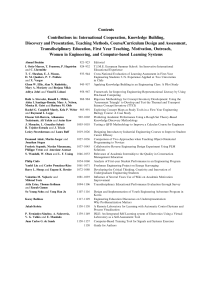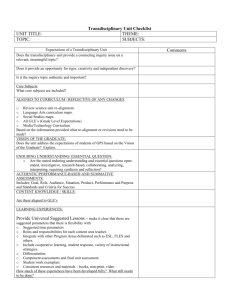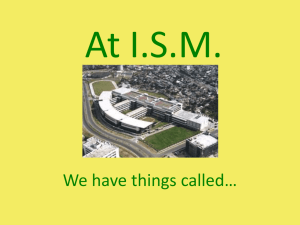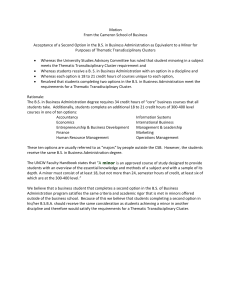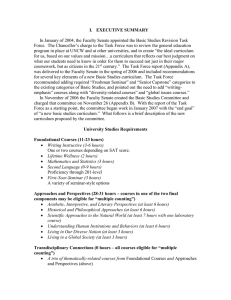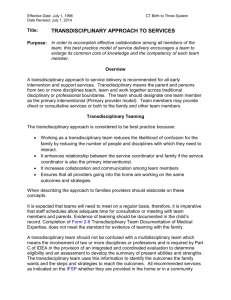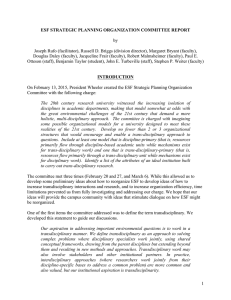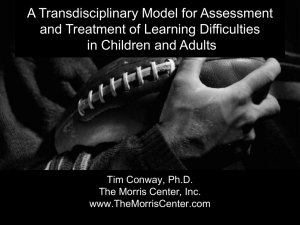ZEF Working Paper
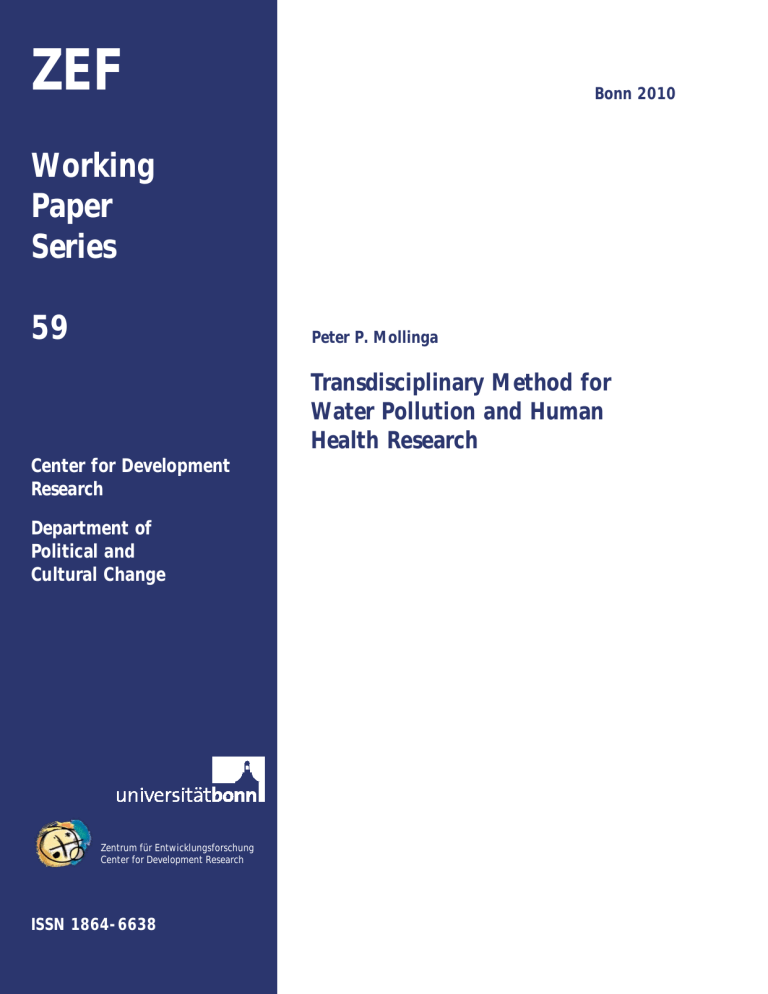
ZEF
Working
Paper
Series
59
Center for Development
Research
Department of
Political and
Cultural Change
Zentrum für Entwicklungsforschung
Center for Development Research
ISSN 1864-6638
Bonn 2010
Peter P. Mollinga
Transdisciplinary Method for
Water Pollution and Human
Health Research
ZEF Working Paper Series, ISSN 1864-6638
Department of Political and Cultural Change
Center for Development Research, University of Bonn
Editors: H.-D. Evers, Solvay Gerke, Peter P. Mollinga, Conrad Schetter
Authors address
PD Dr. Peter P. Mollinga
Center for Development Research (ZEF), University of Bonn,
Walter-Flex-Str. 3
53113 Bonn, Germany
Tel. 0049 (0)228-73 4918: Fax 0228-731972
E-mail: pmollinga@uni-bonn.de www.zef.de
Transdisciplinary Method for Water Pollution and
Human Health Research
Peter P. Mollinga
2 Boundary crossing: concepts, objects and settings
3 Operationalising design principles for transdisciplinary research
i
Abstract
This paper discusses how to go about designing an interdisciplinary or transdisciplinary research project or programme, with ZEF’s research initiative on ‘water pollution and human health’ in India as the background of the presentation. A summary is given of Pohl and Hirsch Hadorn’s (2007) main arguments regarding ‘design principles’ for inter- and transdisciplinary research, and the basic tools they have developed for this are discussed in the context of ZEF’s ‘water pollution and human health’ research initiative.
Keywords: transdisciplinarity, human health, water pollution, method ii
1 Introduction
This paper was written as part of the process of designing a research project proposal on ‘Water pollution and health in India’.
In that process we hoped to design, together with partners, an interdisciplinary research project or programme, if not a transdisciplinary research project or programme.
Based on earlier experience in ZEF and other research projects we know all too well what the difficulties are in conducting interdisciplinary research. Some of the concrete experiences with inter- and transdisciplinary research on natural resources management topics are now starting to be written up and reflected upon systematically. One outcome of such analysis and reflection is Pohl and Hirsch Hadorn’s
2007 publication called Principles for designing transdisciplinary research .
Apart from doing concrete research on ‘water pollution and health’ issues in India, ZEF also would like to use this initiative to explore how to systematically design inter- and transdisciplinary research, in order to learn how to do that better. As a starting point for this ‘process dimension’ of the initiative this paper summarises the ‘principles’ for effective transdisciplinary research that are identified in the just mentioned publication, and elsewhere, and reflects on what this might entail for the ‘water pollution and health’ initiative.
At the start, it is important to describe what is meant by the terms interdisciplinary and transdisciplinary research. Pohl and Hirsch Hadorn (2007) contains three Annexes, of together 27 pages (ibid.: 70-97), in which the different definitions, terminology used and meanings ascribed are presented. Crudely put, interdisciplinary research is research in which a jointly defined problem is collaboratively analysed by researchers with different disciplinary backgrounds.
The jointness of the problem definition and collaboration in the analysis requires conceptual and methodological work that problematises the disciplinary ‘givens’, that is, each researcher’s approach will have to be conceptually and methodologically adapted to ‘fit in’. This stands in contrast with multi-disciplinary research – where disciplinary approaches remain untouched, and all disciplines basically ‘do their own thing’, in parallel one could say. Interdisciplinary research can be a fully academic exercise of academic researchers amongst themselves, though it does not have to be that necessarily. It can also be more policy and/or practice oriented, and be embedded in societal contexts quite specifically. Often such research is required to come up with solutions, options or recommendations for concrete societal problems that a research funder wants resolved.
In transdisciplinary research this ‘embedding’ becomes a much more serious affair. In transdisciplinary research so called ‘stakeholders’ (interest groups) are intimately involved in research formulation and implementation, affecting the way ‘science is done’ deeply. One way to formulate the core idea of transdisciplinarity is that transdisciplinary research aims to democratise scientific practice. It is often
‘participatory’ in nature, with strong understandings of participation implied. Put yet differently, stakeholders/interest groups are not just consulted, investigated, funding agents or handed over the results, but they are involved in the design, governance as well as the implementation of the research.
As stated above, there is no single understanding of these terms, and terminology itself is plural, but this is roughly how we understand these two notions at present. What we aim at in the ‘water pollution and health’ initiative in India, is to achieve proper interdisciplinary research, preferably with strong elements of stakeholder/interest group involvement.
In our initial thinking about the process dimension of the research initiative two things have been central.
1 The paper emerged in the joint work with my ZEF colleague Dr Saravanan S.V. of designing the research project. I thank him for the pleasant discussions and collaboration, and gratefully acknowledge his help in finalising this paper.
2 The reference is collaborative research by groups of researchers. Interdisciplinarity can also be done individually, but the scale and complexity of the issues being considered here usually requires group effort.
1.
To be interdisciplinary a joint problem definition is essential. Therefore, a lot of attention needs to be given to the partnerships that will constitute the initiative. The partnerships are the location where shared problem definition occurs. This initiative should not be a ‘one-off’ assembly work project, but a more wide ranging programmatic effort. Some parts of it may not even require external funding, even when the aim is to design a joint project/programme for intensive implementation that will require such external funding. Part of the joint problem definition, and the conceptual and methodological ‘matching’ part of that, is a normative
‘matching’. Inherently, research is shaped by certain (human development) concerns, having to do with standpoints on questions like equity/welfare, democracy and sustainability – the standard big three normative points of orientation of ‘engaged’ development research. We would position ourselves in a ‘critical’ research tradition, that is, a tradition that attempts to be both self-consciously reflective and aim at practical contributions to human development.
2.
The research has to link up with existing processes of societal activity and transformation. This means that the research would seek collaboration around issues that are ‘ongoing’, that is, actively discussed and contested in society, where things are happening, and where there is a configuration of stakeholders/interest groups not only abstractly extant, but concretely engaged in negotiating, advocating or otherwise shaping the future. Hence our search for suitable ‘cases’ or ‘issue networks’. Part of this is also the long term engagement that is envisaged. Though any research project is of fixed and limited duration, societal processes are ongoing, and we would aim to frame our bounded research effort in that context. None of the partners will be novices to the region or the subject matter, and they will have long standing engagements and embeddedness each in their own way.
These are very general beginnings. The decision to focus on ‘water pollution and health’ is ours. An inventory was made of the literature on ‘environment and health’, and within that potential fields of interest were identified (by Saravanan S.V., see footnote 1). We decided, at ZEF, that the water pollution
– health connection might be an interesting and important topic for research. The step to be taken in designing a research project and programme is to identify concrete problem areas around which to organise the research. The expectation is that there will be no scarcity of ‘cases’ and ‘issue networks’ to link research to among the plethora of concrete human development issues in a fast changing India, or for that matter, any other part of the world.
This paper attempts to move from such general statements of intent and principle to more concrete and practical aspects of research design – including the trade-offs involved. This is done in two steps. First, in section 2, I summarise the three main challenges of the ‘boundary crossing’ that interdisciplinary and transdisciplinary research involves. The second step, section 3, looks concretely at the ‘principles for designing transdisciplinary research’ that Pohl and Hirsch Hadorn discuss in their book.
2
Boundary crossing: concepts, objects and settings
The challenges posed by interdisciplinary and transdisciplinary research can be subdivided into three classes. The general metaphor used is that of inter- and transdisciplinary research being an exercise in
‘crossing boundaries’, the title of Klein’s book on interdisciplinarity (Klein, 1996). The main boundaries to be crossed are those between disciplines (including schools of thought within disciplines) and between science and society. The framework developed looks at what needs to be done ‘at the boundary’ to achieve constructive collaboration and/or action. The three types of ‘boundary work’ that need to be done, or challenges that inter-and transdisciplinary research pose are the following.
1.
The development of suitable boundary concepts to think multidimensionality.
3 See Burawoy (2005a, 2005b) for advocacy of a ‘public sociology’, in which ‘sociology’ can be replaced by any discipline or interdiscipline.
4 This section summarises the basic framework for understanding the ‘boundary work’ inherent to interdisciplinary and transdisciplinary research as developed in Mollinga (2008, 2010).
2.
The construction of workable boundary objects to make assessments and take decisions in conditions of incomplete knowledge, uncertainty, complexity and non-congruent interests.
3.
The crafting of conducive boundary settings , that is, shaping the internal and external institutional arrangements of research in such a way that the first two can be achieved effectively.
The first challenge or class refers to the necessary conceptual/theoretical and methodological work to capture the multidimensionality of concrete human development problems, including those of water pollution and health. Disciplinary perspectives commonly abstract along one dimension (reductionism).
In concrete problem settings these different dimensions have to be ‘integrated’ somehow, that is, understood simultaneously , as connected dimensions. A clear example is the concept of ‘value’, and related methodologies of ‘valuation’. The highly polarised discussion in India, as elsewhere, on the ‘value’ of water underscores the difficulties involved in seeing the interconnections, and avoid digging in into reductionist positions (be they productivist, economistic or culturalist). Methodological difficulties have to do with designing and using appropriate valuation methods, and the issue of (in)commensurability of values for example. Other examples are concepts of ‘risk and vulnerability’, ‘scarcity’, ‘efficiency’, and many others. ‘Joint problem definition’ and ‘joint analysis’ includes engaging which such conceptual and methodological questions.
The second challenge or class starts from the observation that in concrete situations where decisions have to be made and courses of action decided, at whatever level this may be, approaches are needed that can help in this decision making even when data is incomplete and of different types, systems are complex, and characterised by uncertainty, and where different and conflicting interests are involved – that is, in almost all natural resources management and human development decision making situations.
The ‘devices’ developed for and employed in such situations are called ‘boundary objects’. They come in three forms: a) different types of ‘models’, well known are those used as ‘decision support systems’; 2) assessment frameworks, that is, different methods for ‘integrated assessment’; 3) participatory processes, that is, methods focussing on how to organise or facilitate decision making. The three are not necessarily exclusive, but tend to exist relatively independently, very crudely put, as science driven, state and corporate sector driven, and civil society driven approaches.
The third challenge or class looks at the details of crafting ‘enabling’ institutional conditions for inter- and transdisciplinary research projects, internally (within the project) and externally (the project in relation to the rest of the world). In transdisciplinary research the distinction between internal and external, of course, to a large extent breaks down, but the issue of institutional arrangements remains.
‘Internal’ institutional arrangements refer to the division of labour in research projects and programmes, incentive structures for collaboration, communication strategies, transparency of decision making/internal governance and management, budget control, et cetera. ‘External’ institutional arrangements refer to the relationships with funding agencies, ‘target groups’, ‘beneficiaries’,
‘stakeholders’ or ‘interest groups’, whatever the preferred terminology may be, relations with the general public, with policy makers, and so forth. A lot of debate on the problems of conducting interdisciplinary and transdisciplinary research focuses on this third challenge. It is no doubt very important, but it is only one class of challenges.
How does this distinction of three types of challenges help us? One way is that it helps not to confuse problems, or assume that a ‘solution’ of/in one class of problems implies having solved everything. Good communication and research governance does not automatically generate quality science; the production of quality science does not guarantee applicability or even relevance for concrete problem solving; facilitating a participatory and democratic decision making process excellently does not automatically generate consensus or resolution of conflicts; and so forth. This may sound obvious, and should be obvious, but such confusion is rampant in actually existing collaborative (interdisciplinary) research in our own experience.
The second way in which this threefold division of challenges may help is that it is the beginning of more concrete unravelling of the issues we need to address when designing and doing inter- and transdisciplinary research (and, for that matter, to a large extent also in collaborative disciplinary
research). We can also look at the ambitions of the research more concretely: are these located in all three fields, and equally strongly, or are we ‘conventional’ in one sense but ‘vanguard’ in another?
Thirdly, we can use it as a tool for identifying our own strengths and weaknesses. Where do we have knowledge, skills and experience, and where do we lack them? How can these be supplemented? How can partners complement each other in this respect? Where do we need to bring in others’ knowledge, skill and experience? Where do we have to acquire new knowledge, skill and experience ourselves?
There is an emerging and fast growing literature on such questions, which can be made use of in designing and implementing a specific project or programme. However, no recipes are available and translation to specific conditions and problematic is always required.
The next logical question then is how to go about systematically addressing this generic set of issues in a concrete research initiative. That is the subject of the next section.
3 Operationalising design principles for transdisciplinary research
This section summarises the approach proposed in Pohl and Hirsh Hadorn (2007) for conducting transdisciplinary research (TR).
According to these authors “[t]here is a need for TR when knowledge about a societally relevant problem field is uncertain, when the concrete nature of problems is disputed, and when there is a great deal at stake for those concerned by problems and involved in dealing with them.” (ibid.:20) This can safely be said to apply to most water resources management and health issues in India and elsewhere. Questions like public vs. private provision of water supply and health services,
(in)equity in access to these services, the (in)sufficiency of technological solutions for achieving sustainable services, (non)availability of data, the poor level of understanding of water pollution – health causal connections, and many others, are actively discussed, contested and acted upon at different levels
– from the individual and household level, to the national level policy domain, to global water and health standards, treaties, covenants, and programmes. Both water and health are core to human development and part of basic human rights definitions – the stakes are therefore high.
TR aims to do research in such a way that: a.
it grasps the complexity of problems; b.
it takes into account the diversity of life-world and scientific perceptions of problems; c.
it links abstract and case-specific knowledge; d.
it develops knowledge and practices that promote what is perceived to be the common good.
(ibid.:20)
These are understood by Pohl and Hirsch Hadorn as requirements for TR.
TR, though being a distinct type of research, has several things in common with other research types, notably that it is an iterative process of a) problem identification and structuring, b) problem analysis, and c) bringing results to fruition. (ibid.:20) These three elements can be seen as phases, but certainly in
TR they occur in a continuing and iterative cycle. This design characteristic often does not sit well with research funding criteria, in India as elsewhere. The submission of project proposals often forces researchers into defining ‘deliverables’ and ‘milestones’ for different points in time in a two to five year period, and to suggest that they are highly confident about the outcomes, if not the societal impacts, that will be achieved. Though such frameworks are meant to create a degree of accountability of researchers to research funders, which is an understandable objective, they also create administrative and financial rigidities that can easily contradict the iterative and flexible nature of TR that was just described. The framing of research proposals, be they for research funding agencies, or internally within a
5 The empirical reference of the book is experience in European collaborative research projects on natural resource management and ecological sustainability issues particularly. My main objective is to present the tools that Pohl and Hirsch Hadorn present, using their four principles as the organising device. However, their own presentation is structured somewhat differently – for which I refer to the publication itself.
university department or research institute, is itself a case of ‘boundary work’, in which different constituencies and concerns need to be negotiated to achieve the fine balance between prioritisation, accountability and proper planning needed on one side, and the flexibility and openness required to deal with real world issues adequately on the other. In other words, in practice there tends to be a situation in which science-driven research interests have to be balanced with society-driven research interests.
How that balance is struck varies a great deal from case to case. TR is a type of research that works strongly from society-driven research interests – what Pohl and Hirsch Hadorn call, in rather neutral phrasing, as aiming at the ‘common good’. This functions as the ‘regulative idea’ of TR. “The transdisciplinary research process should clarify how to understand the concept of the common good and its implications as a normative principle for dealing with problems in the life-world. “ (ibid.:29)
To shape the TR research process and to keep it within practicable boundaries, Pohl and Hirsch Hadorn
(2007) formulate and discuss four principles.
1.
Reduce complexity by specifying the need for knowledge and identifying those involved.
2.
Achieve effectiveness through contextualisation.
3.
Achieve integration through open encounters.
4.
Develop reflexivity through recursiveness.
I discuss below what is meant with these principles and present the tools the two authors suggest for operationalising them. I also comment on the potential relevance and implications for the ‘water pollution and health’ research initiative. However, the implementation of these principles assumes the identification of a ‘societally relevant problem field’ as the subject matter to which this operationalisation is applied. In general terms the ‘water pollution and health’ problem field is evidently societally relevant. However, what is needed for concrete research is to specify this in much greater detail for the particular case or issue network concerned. This detailed description must fulfil the four requirements as listed above (ibid.:27).
1.
On complexity : the description must include the relevant relations between the social and natural factors that constitute the problem and that might influence possible solutions (in my own words, a conceptual model of the problem needs to be made). This requires grasping the dynamic interdependencies of empirical insights, technical options, value orientations and policy options (in my own words, part of problem definition is a strategic assessment of the direction into which one would like to move for seeking solutions).
2.
On diversity of perspectives : existing diversity in perspectives may not be complementary, but is likely to be contradictory. Nevertheless diverse perspectives need to be taken into account in a problem definition as well as subsequent steps, by looking at the contribution they can make to problem solution. It also means that ‘perception correction’ is part of the research process (in my own words, research involves an organised learning process, not just at the level of knowledge acquired, but also at the level of how the problem is perceived in the first place, which starts with a serious description of the diversity of perspectives and their acknowledgement).
Participatory research design and methods, as well as conscious focus on communication, learning and negotiation frameworks are important tools for making diversity an asset. In sometimes strongly polarised situations around water and health issues, achieving this is a great challenge. It is at this point that linking with existing processes is very important, as such processes tend to be long-duration, longer than a distinct research project.
3.
On linking abstract and case specific knowledge : producing relevant knowledge is one thing, making it practically work is another. ‘Working with knowledge’ is not a trivial matter of
‘dissemination’ or ‘transfer’, that is of availability only, but a more complex process. In the words of Cash et al. (2003), to find application, and apart from being available, knowledge needs to be credible (often the single focus of academic researchers, ‘good’ knowledge), it needs to be salient
6 Pohl and Hirsch Hadorn note that being oriented towards the common good is not the privilege of TR – it can also be part of basic and applied research. However, what is characteristic of tR is that it attempts to fulfil all four requirements listed (Pohl and Hirsch Hadorn, 2007: 35-36)
(effectively speak to a concrete problem, be perceived as truly relevant by users and decisionmakers) and it needs to be legitimate (it matters who the carrier(s) or owner(s) of the knowledge is/are, and in what process and setting it has been produced). Part of the problem field identification/description thus needs to be how this ‘working with knowledge’ is envisaged, with what kind of knowledge this is feasible, what approaches are practical etc.
4.
On promoting the common good : One of the research questions in a TR project would be how to define the concept of the common good with regard to the specific problem at hand. It has to be acknowledged that actor groups in the private sector, public agencies and civil society can hold controversial (and contradictory) positions. TR would aim at consensus on solutions. In the
Indian context and many other settings where stakes are high and social divisions deep, such formulations can easily sound idealistic. It assumes a certain degree of willingness among actor groups to engage in this manner. Achieving that willingness is again not a trivial, and often a strongly political and politicised, matter. If absent, constructive research becomes rather difficult. The implication seems to be that not all situations lend themselves for a TR input/approach. The problem field definition/description needs to identify the contours of that
‘willingness’, one might say, it has to include a ‘political feasibility’ assessment.
I now move to the operational aspects of designing TR by discussing the four principles and suggested tools.
First principle: Reduce complexity by specifying the need for knowledge and identifying those involved
The complexity of a problem can easily be overwhelming – everything seems to be related to everything else. The TR way through this is to focus on those relations that are relevant to practice-oriented problem solving (‘what can we do/do we want to do about negative effects of water pollution on health in this situation and what do we therefore need to know’). The trick is thus to reduce complexity based on the need for knowledge of those involved (ibid.:21). This principle is relevant in all three phases identified above, but particularly in the phase of identifying and structuring problem fields. The reduction of complexity requires a mapping of what different actors and disciplines involved in a problem think and feel about the issue and how they relate to it, and what they could contribute to the achievement/fulfilment of the TR requirements. In a matrix this looks as follows.
Tool 1: Identifying the actors involved with regard to TR requirements
Actors involved
Requirements for TR a) Complexity of problems b) Diversity of perceptions c) Abstract and case-specific knowledge d) Knowledge and practices that promote what is perceived to be the common good
Source: Pohl and Hirsch Hadorn (2007:30)
Such a matrix could be a tool in a participatory process of problem field definition. To develop concrete research questions on the basis of such mapping (what knowledge do we – thus – need, and what questions do we – therefore – need to ask?), a distinction is made between three types of knowledge that are part of TR: systems knowledge, target knowledge and transformation knowledge, which need to be clearly distinguished and their interrelation understood. This gets clarified in the second tool as presented below in the ‘Tool 2’ table.
The first two columns of that table describe the types of knowledge just mentioned, for each of which research questions would be formulated. The third column identifies the main challenge involved in developing such knowledge/answering such questions. The fourth column refers to a list of three questions that can help in identifying the connections between the three types of knowledge.
The tool invites its users to identify the implicit references and assumptions about other types of knowledge that inform a particular research question, and to make these explicit. For instance, when we formulate a research question about the dynamics of a particular system (about a particular mechanism operating in it for example), we should also ask what we have implicitly assumed/incorporated into that question as regards the targeted change/solution, and how to make that work. For example, when the research question is one about price distortion in a particular commodity market (systems knowledge), we may have assumed that a ‘free market’ would be undistorted and are the target to be achieved
(target knowledge), and that for this certain policies need to be in place (transformation knowledge). If our assumptions about target and transformation would be different, our systems questions would also be different.
The three questions that can be used for tracing such references and assumptions in a particular research question are the following (Pohl and Hirsch Hadorn, 2007:40).
1.
To what understanding of the genesis and possible development of a problem and life-world interpretations of it does the research question refer?
2.
To what kind of need for change, desired goals and better practices does the research question refer?
3.
To what technical, social, cultural and other possible means of acting does the research question refer?
Tool 2: Positioning the need for knowledge with regard to the three forms of knowledge
Research questions Particular challenge
Questions to help with positioning
Questions about the genesis and possible development of a problem and about life-world interpretations of a problem
Reflecting on and dealing with uncertainties with the help of realworld experiments 2, 3
Questions related to determining and explaining the need for change, desired goals and better practices
Clarifying and prioritising diverse perceptions of targets and values, taking into account the common good as a regulatory principle
1, 3
Questions about technical, social, cultural, legal and other possible means of acting to transform existing practices and introduce desired ones
Learning how to make existing technologies, regulations, practices and power relations more flexible 1,2
Source: Pohl and Hirsch Hadorn (2007:40)
For the ‘water pollution and health’ initiative this would imply that an ‘actor mapping’, ‘perspective mapping’ and ‘contribution mapping’ for the ‘cases’ we are considering needs to be done. As a first step that would be done based on available information, discussion and exchange among potential partners, to identify a set of suitable cases. A next step would be to do this more in detail in the case locations and with actor groups involved. That would, in fact, be the beginning of the actual research, or an
activity preceding the formulation of a larger scale project proposal. It requires time and financial resources.
Second principle: Achieve effectiveness through contextualisation
Contextualising research is to a large extent about assuring impact of the research activities. Pohl and
Hirsch Hadorn suggest making ‘impact models’ as part of the research (design). These are conceptual models that show the (assumed) relations between research results, their use, and the effects and impacts of that (2007:63). There will be a multiplicity of impacts, and a multiplicity of views on how impact occurs (what the mechanisms are that produce impact), which need to be adequately described and understood. The purpose of this is to ‘tailor results for the target group’. Or put differently, research results need to be embedded in the life-world of different actors. For mapping this, Pohl and Hirsch
Hadorn present Tool 4 and Tool 5, for embedding in society and for embedding in the scientific world respectively. The matrices are reproduced below.
The basic point is to do strategic planning of outputs/results and how these will be put to work, in all stages of the project/research activity.
Tool 4: Embedding TR in the life-world
Questions about the impact model
What impact is intended?
What existing needs, interests, technologies, regulations, practices and power relations need to be taken into account?
What causal relationships are initially assumed?
In what form and at what point in time can results be introduced in a way tailored for the target group?
What are likely unintended impacts, and what
‘probes’ may reveal them?
Area of impact
Private sector Civil society
Source: Pohl and Hirsch Hadorn (2007:65)
Public agencies
7 The fact that Tool 4 and 5 follow Tool 2 above, and Tool 3 comes only later is due to the different organisation of the presentation in this paper than in the book. I kept the numbering of the tools as in the source for easy reference.
Tool 5: Embedding TR in the scientific environment
Project phase
Strategic elements
Goals
(scientific/science policy)
Contents
(state of the art in relevant disciplines/ state of the art in transdisciplinary research/ future research areas/ need for institutional action)
Addressees
(disciplines/ transdisciplinary groups/ science policy actors)
Forms
(publications/ organisation of conferences/ initiation of research programmes/ development of networks/ writing of official statements)
Problem identification and structuring
Third principle: Achieve integration through open encounters
The third principle directly addresses the process dimension of TR research, that is, the forms of collaboration and integration within the research activity. The general principle of collaboration and integration in TR is that of open encounters , which means that, as the basis of a constructive approach,
“participants ask themselves about the significance of other perspectives in relation to their own perspective.” (Pohl and Hirsch Hadorn, 2007:57) These encounters can be organised in a variety of ways, through different types of ‘boundary work’. Pohl and Hirsch Hadorn (2007:53, Figure 10) present four types of collaboration in research projects (following Rossini and Porter, 1979:74 who call these ‘sociocognitive frameworks for integrating interdisciplinary research’).
1.
Common group learning
2.
Modelling
3.
Negotiation among experts
4.
Integration by leader
Each of these has its own organisational pattern, division of labour and communication methods. Based on this, three ‘modes of integration’ are defined, within each of which modelling can be used. The perspective is summarised in the Tool 3 table presented below. On the horizontal axis there are three forms of collaboration, on the vertical axis different ‘tools’. The latter are basically different types of boundary concepts and boundary objects as discussed above in section two. Research on the practice of interdisciplinary and transdisciplinary research could usefully focus on the types and modes of functioning of boundary concepts and boundary objects. The existing literature on the subject would already allow more precise specification and extension of the list of ‘tools’ than in Pohl and Hirsch-
Hadorn’s summary.
Pohl and Hirsch Hadorn focus on the cognitive dimension of collaboration and integration, and emphasise the recursiveness of the research process in general (see the fourth principle below), but do not discuss the ‘nitty gritty’ of institutional arrangements in research projects. These include for instance how ‘work packages’ are organised, how common databases are set up and managed, how budgets are managed, how day-to-day decision making on research planning is organised , what incentive structures
can be created for collaborative work, etc. For these aspects of TR design other sources will have to be mobilised. The literature on social learning may provide good insights.
Tool 3: Forms of collaboration and modes of integration
Modes of integration
Boundary object
Glossary
Everyday language
Models
Mutual adaptation of concepts
Transfer of concepts
Bridge concepts
Common group learning
(search for something new)
Forms of collaboration
Negotiation among experts
(give and take)
Integration by a leader
(give or take)
Source: Pohl and Hirsch Hadorn (2007:59)
Given the way we are embarking on the ‘water pollution and health’ project, ‘common group learning’ seems to be the most important form of collaboration to start off with. After all, as stated in the beginning of this paper, part of the agenda is to learn about designing and implementing an interdisciplinary research project with transdisciplinary components. Normatively, common group learning seems to be a better basis for developing and maintaining a research network than the other two. But common learning is difficult to facilitate and keep the momentum of.
Fourth principle: Develop reflexivity through recursiveness
Recursiveness is another general process characteristic of TR. It basically means iterative reflection, or self-conscious learning. It characterises the whole research process, and is not reserved for any particular phase. Pohl and Hirsch Hadorn (2007) do not present a separate tool for achieving recursiveness. It should be a process characteristic of the employment of the tools presented above. These processes are done well when they are done recursively, in virtuous, learning cycles. As already observed above, the authors focus on the cognitive dimension of this – what needs to be added is an organisational sociology/(knowledge) management science perspective to specify concrete organisational forms and procedures for this. A specific problem for international collaborative projects with partners geographically at large distances is that encounters are generally not very frequent. Modern communication technology may help to partly overcome that, but probably not fully.
On the implementation of principles three and four, a lot of think-work therefore still needs to be done for the ‘water pollution and health’ initiative, and more generally in development research. Some of my personal learning of the past few years in this regard is the following (with no claim to comprehensiveness or general validity).
• Subdividing research projects into work packages along disciplinary lines may seem attractive because it reduces the transaction costs of collaboration (many academics are reasonably individualistic and prefer to work on their own), but it can easily undermine the working from a common problem definition, and the sharing of knowledge. The question of ‘integration’ is thus pushed forward in time and becomes more difficult to achieve.
• Encounters of different disciplines and actor groups have to be forced, that is made unavoidable through the way the project is organised, while otherwise there is a tendency to avoid them.
Metaphorically put, unless people lock themselves up in a room together, collaboration and integration can easily remain elusive. This is a major task for research project manager(s).
• Transparency in the governance of a project is of utmost importance. Inter- and transdisciplinary research have a strong element of equal partnership (though not necessarily, see above under the third principle), and centralised decision making in the hand of one or a few of the partners militates against that.
• Particularly important in this respect is transparency in financial (budget) management. Active care should be taken that control over budgets is not used as an instrument of power.
Transparency is accompanied by accountability, where all partners should be equally accountable.
• Technological devices like websites and electronic databases do not necessarily induce interaction and sharing among researchers (nor between the project and society).
Communication is (also and very much) a cultural process and has to be addressed as such.
• Gender relations and the relations between junior and senior researchers should be a special point of attention in project design and implementation.
• Time and money resources devoted to the specific organisational and managerial aspects of interdisciplinary research are often grossly insufficient.
• The most important factor for successful interdisciplinary and transdisciplinary research is to spend sufficient time, effort and creativity on formulating a joint problem definition and research question. This is only possible when the commitment to the chosen research approach is similar across participants – at whatever level of ambition that approach may be pitched.
4 Concluding remarks
The account above is intended to spark discussion and further thinking on how the ‘water pollution and health’ research initiative, and by implication, other research efforts, might be designed and implemented as an interdisciplinary and possibly transdisciplinary project, by identifying what issues need to be addressed in such a process. The presentation is far from comprehensive, as indicated in the text above already. It hopefully does show that how a project or programme is designed and implemented is not self evident, and that considerable time and attention needs to be given to thinking that through before the ‘hands on’ research activities start. This paper note will hopefully serve as a device, dare I say a ‘boundary object’, for getting to know research partners’ perspectives and interests better. We look forward to open encounters.
References
Burawoy, Michael. 2005a. ‘For Public Sociology’. American Sociological Review , Vol. 70, February:4-28.
URL: http://sociology.berkeley.edu/faculty/burawoy/burawoy_pdf/2004PresidentialAddressASR.pdf
(accessed 27 July 2007)
Burawoy, Michael. 2005b. ‘Forging Public Sociologies on National, Regional and Global; Terrains’ E-
Bulletin, The International Sociological Association , No.2: 42-52 (2005) URL: http://sociology.berkeley.edu/faculty/burawoy/burawoy_pdf/PS.Forging%20PS.ISA.pdf
(accessed 27
July 2007)
Klein, Julie Thompson. 1996. Crossing Boundaries, Knowledge, Disciplinarities, and Interdisciplinarities
Charlottesville, London: University Press of Virginia
Mollinga, Peter P.
2008 . The Rational Organisation of Dissent. Interdisciplinarity in the study of natural resources management.
ZEF Working Paper 33. ZEF, Bonn, Germany. http://www.zef.de/fileadmin/webfiles/downloads/zef_wp/WP33_Mollinga.pdf
(accessed 15 July
2010)
Mollinga, Peter P. (2010) ‘Boundary work and the complexity of natural resources management’. Crop
Science 50:S1-S9
Pohl, Christian and Gertrude Hirsch Hadorn. 2007. Principles for Designing Transdisciplinary Research.
Oekom Verlag, München
Rossini, F.A. and A.L. Porter. 1979. ‘Frameworks for integrating disciplinary research’ Research Policy 8:
70-79
ZEF Working Paper Series, ISSN 1864-6638
Department of Political and Cultural Change
Center for Development Research, University of Bonn
Editors: H.-D. Evers, Solvay Gerke, Conrad Schetter
1 Evers, Hans-Dieter and Solvay Gerke (2005). Closing the Digital Divide: Southeast Asia’s Path Towards a Knowledge Society.
2 Bhuiyan, Shajahan and Hans-Dieter Evers (2005). Social Capital and Sustainable Development: Theories and Concepts.
3 Schetter, Conrad (2005). Ethnicity and the Political Reconstruction of Afghanistan.
4 Kassahun, Samson (2005). Social Capital and Community Efficacy. In Poor Localities of Addis Ababa Ethiopia.
5 Fuest, Veronika (2005). Policies, Practices and Outcomes of Demand-oriented Community Water Supply in Ghana: The National
Community Water and Sanitation Programme 1994 – 2004.
6 Menkhoff, Thomas and Hans-Dieter Evers (2005). Strategic Groups in a Knowledge Society: Knowledge Elites as Drivers of
Biotechnology Development in Singapore.
7 Mollinga, Peter P. (2005). The Water Resources Policy Process in India: Centralisation, Polarisation and New Demands on Governance.
8 Evers, Hans-Dieter (2005). Wissen ist Macht: Experten als Strategische Gruppe.
8a Evers, Hans-Dieter and Solvay Gerke (2005). Knowledge is Power: Experts as Strategic Group.
9 Fuest, Veronika (2005). Partnerschaft, Patronage oder Paternalismus? Eine empirische Analyse der Praxis universitärer
Forschungskooperation mit Entwicklungsländern.
10 Laube, Wolfram (2005). Promise and Perils of Water Reform: Perspectives from Northern Ghana.
11 Mollinga, Peter P. (2004). Sleeping with the Enemy: Dichotomies and Polarisation in Indian Policy Debates on the Environmental and
Social Effects of Irrigation.
12 Wall, Caleb (2006). Knowledge for Development: Local and External Knowledge in Development Research.
13 Laube, Wolfram and Eva Youkhana (2006). Cultural, Socio-Economic and Political Con-straints for Virtual Water Trade: Perspectives from the Volta Basin, West Africa.
14 Hornidge, Anna-Katharina (2006). Singapore: The Knowledge-Hub in the Straits of Malacca.
15 Evers, Hans-Dieter and Caleb Wall (2006). Knowledge Loss: Managing Local Knowledge in Rural Uzbekistan.
16 Youkhana, Eva, Lautze, J. and B. Barry (2006). Changing Interfaces in Volta Basin Water Management: Customary, National and
Transboundary.
17 Evers, Hans-Dieter and Solvay Gerke (2006). The Strategic Importance of the Straits of Malacca for World Trade and Regional
Development.
18 Hornidge, Anna-Katharina (2006). Defining Knowledge in Germany and Singapore: Do the Country-Specific Definitions of Knowledge
Converge?
19 Mollinga, Peter M. (2007). Water Policy – Water Politics: Social Engineering and Strategic Action in Water Sector Reform.
20 Evers, Hans-Dieter and Anna-Katharina Hornidge (2007). Knowledge Hubs Along the Straits of Malacca.
21 Sultana, Nayeem (2007). Trans-National Identities, Modes of Networking and Integration in a Multi-Cultural Society. A Study of
Migrant Bangladeshis in Peninsular Malaysia.
22 Yalcin, Resul and Peter M. Mollinga (2007). Institutional Transformation in Uzbekistan’s Agricultural and Water Resources
Administration: The Creation of a New Bureaucracy.
23 Menkhoff, T., Loh, P. H. M., Chua, S. B., Evers, H.-D. and Chay Yue Wah (2007). Riau Vegetables for Singapore Consumers: A
Collaborative Knowledge-Transfer Project Across the Straits of Malacca.
24 Evers, Hans-Dieter and Solvay Gerke (2007). Social and Cultural Dimensions of Market Expansion.
25 Obeng, G. Y., Evers, H.-D., Akuffo, F. O., Braimah, I. and A. Brew-Hammond (2007). Solar PV Rural Electrification and Energy-Poverty
Assessment in Ghana: A Principal Component Analysis.
26 Eguavoen, Irit; E. Youkhana (2008). Small Towns Face Big Challenge. The Management of Piped Systems after the Water Sector
Reform in Ghana.
27 Evers, Hans-Dieter (2008). Knowledge Hubs and Knowledge Clusters: Designing a Knowledge Architecture for Development
28 Ampomah, Ben Y., Adjei, B. and E. Youkhana (2008). The Transboundary Water Resources Management Regime of the Volta Basin.
29 Saravanan.V.S.; McDonald, Geoffrey T. and Peter P. Mollinga (2008). Critical Review of Integrated Water Resources Management:
Moving Beyond Polarised Discourse.
30 Laube, Wolfram; Awo, Martha and Benjamin Schraven (2008). Erratic Rains and Erratic Markets: Environmental change, economic globalisation and the expansion of shallow groundwater irrigation in West Africa.
31 Mollinga, Peter P. (2008). For a Political Sociology of Water Resources Management.
32 Hauck, Jennifer; Youkhana, Eva (2008). Histories of water and fisheries management in Northern Ghana.
33 Mollinga, Peter P. (2008). The Rational Organisation of Dissent. Boundary concepts, boundary objects and boundary settings in the interdisciplinary study of natural resources management.
34 Evers, Hans-Dieter; Gerke, Solvay (2009). Strategic Group Analysis.
35 Evers, Hans-Dieter; Benedikter, Simon (2009). Strategic Group Formation in the Mekong Delta - The Development of a Modern
Hydraulic Society.
36 Obeng, George Yaw; Evers, Hans-Dieter (2009). Solar PV Rural Electrification and Energy-Poverty: A Review and Conceptual
Framework With Reference to Ghana.
37 Scholtes, Fabian (2009). Analysing and explaining power in a capability perspective.
38 Eguavoen, Irit (2009). The Acquisition of Water Storage Facilities in the Abay River Basin, Ethiopia.
39 Hornidge, Anna-Katharina; Mehmood Ul Hassan; Mollinga, Peter P. (2009). ‘Follow the Innovation’ – A joint experimentation and learning approach to transdisciplinary innovation research.
40 Scholtes, Fabian (2009). How does moral knowledge matter in development practice, and how can it be researched?
41 Laube, Wolfram (2009). Creative Bureaucracy: Balancing power in irrigation administration in northern Ghana.
42 Laube, Wolfram (2009). Changing the Course of History? Implementing water reforms in Ghana and South Africa.
43 Scholtes, Fabian (2009). Status quo and prospects of smallholders in the Brazilian sugarcane and ethanol sector: Lessons for development and poverty reduction.
44 Evers, Hans-Dieter, Genschick, Sven, Schraven, Benjamin (2009). Constructing Epistemic Landscapes: Methods of GIS-Based Mapping.
45 Saravanan V.S. (2009). Integration of Policies in Framing Water Management Problem: Analysing Policy Processes using a Bayesian
Network.
46 Saravanan V.S. (2009). Dancing to the Tune of Democracy: Agents Negotiating Power to Decentralise Water Management.
47 Huu, Pham Cong, Rhlers, Eckart, Saravanan, V. Subramanian (2009). Dyke System Planing: Theory and Practice in Can Tho City,
Vietnam.
48 Evers, Hans-Dieter, Bauer, Tatjana (2009). Emerging Epistemic Landscapes: Knowledge Clusters in Ho Chi Minh City and the Mekong
Delta.
49 Reis, Nadine; Mollinga, Peter P. (2009). Microcredit for Rural Water Supply and Sanitation in the Mekong Delta. Policy implementation between the needs for clean water and ‘beautiful latrines’.
50 Gerke, Solvay; Ehlert, Judith (2009). Local Knowledge as Strategic Resource: Fishery in the Seasonal Floodplains of the Mekong Delta,
Vietnam
51 Schraven, Benjamin; Eguavoen, Irit; Manske, Günther (2009). Doctoral degrees for capacity development: Results from a survey among African BiGS-DR alumni.
52 Nguyen, Loan (2010). Legal Framework of the Water Sector in Vietnam.
53 Nguyen, Loan (2010). Problems of Law Enforcement in Vietnam. The Case of Wastewater Management in Can Tho City.
54 Oberkircher, Lisa et al. (2010). Rethinking Water Management in Khorezm, Uzbekistan. Concepts and Recommendations.
55 Waibel, Gabi (2010). State Management in Transition: Understanding Water Resources Management in Vietnam.
56 Saravanan V.S., Mollinga, Peter P. (2010). Water Pollution and Human Health. Transdisciplinary Research on Risk Governance in a
Complex Society.
57 Vormoor, Klaus (2010). Water Engineering, Agricultural Development and Socio-Economic Trends in the Mekong Delta, Vietnam.
58 Hornidge, Anna-Katharina, Kurfürst, Sandra (2010). Envisioning the Future, Conceptualising Public Space. Hanoi and Singapore
Negotiating Spaces for Negotiation.
59 Mollinga, Peter P. (2010). Transdisciplinary Method for Water Pollution and Human Health Research.
60 Youkhana, Eva (2010). Gender and the development of handicraft production in rural Yucatán/Mexico.
61 Naz, Farhat, Saravanan V. Subramanian (2010). Water Management across Space and Time in India.
62 Evers, Hans-Dieter, Nordin, Ramli, Nienkemoer, Pamela (2010). Knowledge Cluster Formation in Peninsular Malaysia: The Emergence of an Epistemic Landscape.
63 Mehmood Ul Hassan, Hornidge, Anna-Katharina (2010). ‘Follow the Innovation’ – The second year of a joint experimentation and learning approach to transdisciplinary research in Uzbekistan.
64 Mollinga, Peter P. (2010). Boundary concepts for interdisciplinary analysis of irrigation water management in South Asia.
65 Noelle-Karimi, Christine (2006). Village Institutions in the Perception of National and International Actors in Afghanistan.
(Amu Darya Project Working Paper No. 1)
66 Kuzmits, Bernd (2006). Cross-bordering Water Management in Central Asia.
(Amu Darya Project Working Paper No. 2)
67 Schetter, Conrad, Glassner, Rainer, Karokhail, Masood (2006). Understanding Local Violence. Security Arrangements in Kandahar,
Kunduz and Paktia.
(Amu Darya Project Working Paper No. 3)
68 Shah, Usman (2007). Livelihoods in the Asqalan and Sufi-Qarayateem Canal Irrigation Systems in the Kunduz River Basin.
(Amu Darya Project Working Paper No. 4)
69 ter Steege, Bernie (2007). Infrastructure and Water Distribution in the Asqalan and Sufi-Qarayateem Canal Irrigation Systems in the
Kunduz River Basin.
(Amu Darya Project Working Paper No. 5)
70 Mielke, Katja (2007). On The Concept of ‘Village’ in Northeastern Afghanistan. Explorations from Kunduz Province.
(Amu Darya Project Working Paper No. 6)
71 Mielke, Katja, Glassner, Rainer, Schetter, Conrad, Yarash, Nasratullah (2007). Local Governance in Warsaj and Farkhar Districts.
(Amu Darya Project Working Paper No. 7)
72 Meininghaus, Esther (2007). Legal Pluralism in Afghanistan.
(Amu Darya Project Working Paper No. 8)
73 Yarash, Nasratullah, Smith, Paul, Mielke, Katja (2010). The fuel economy of mountain villages in Ishkamish and Burka (Northeast
Afghanistan). Rural subsistence and urban marketing patterns.
(Amu Darya Project Working Paper No. 9)
74 Oberkircher, Lisa (2011). ‘Stay – We Will Serve You Plov!’. Puzzles and pitfalls of water research in rural Uzbekistan.
75 Shtaltovna, Anastasiya, Hornidge, Anna-Katharina, Mollinga, Peter P. (2011). The Reinvention of Agricultural Service Organisations in
Uzbekistan – a Machine-Tractor Park in the Khorezm Region.
76 Stellmacher, Till, Grote, Ulrike (2011). Forest Coffee Certification in Ethiopia: Economic Boon or Ecological Bane? http://www.zef.de/workingpapers.html
ZEF Development Studies
edited by Solvay Gerke and Hans-Dieter Evers
Center for Development Research (ZEF),
University of Bonn
Shahjahan H. Bhuiyan
Benefits of Social Capital. Urban Solid Waste
Management in Bangladesh
Vol. 1, 2005, 288 p., 19.90 EUR, br. ISBN 3-8258-
8382-5
Veronika Fuest
Demand-oriented Community Water Supply in
Ghana. Policies, Practices and Outcomes
Vol. 2, 2006, 160 p., 19.90 EUR, br. ISBN 3-8258-
9669-2
Anna-Katharina Hornidge
Knowledge Society. Vision and Social Construction of Reality in Germany and Singapore
Vol. 3, 2007, 200 p., 19.90 EUR, br. ISBN 978-3-
8258-0701-6
Wolfram Laube
Changing Natural Resource Regimes in Northern
Ghana. Actors, Structures and Institutions
Vol. 4, 2007, 392 p., 34.90 EUR, br. ISBN 978-3-
8258-0641-5
Lirong Liu
Wirtschaftliche Freiheit und Wachstum. Eine international vergleichende Studie
Vol. 5, 2007, 200 p., 19.90 EUR, br. ISBN 978-3-
8258-0701-6
Phuc Xuan To
Forest Property in the Vietnamese Uplands. An
Ethnography of Forest Relations in Three Dao
Villages
Vol. 6, 2007, 296 p., 29.90 EUR, br. ISBN 978-3-
8258-0773-3
Caleb R.L. Wall, Peter P. Mollinga (Eds.)
Fieldwork in Difficult Environments. Methodology as Boundary Work in Development Research
Vol. 7, 2008, 192 p., 19.90 EUR, br. ISBN 978-3-
8258-1383-3
Solvay Gerke, Hans-Dieter Evers, Anna-K. Hornidge
(Eds.)
The Straits of Malacca. Knowledge and Diversity
Vol. 8, 2008, 240 p., 29.90 EUR, br. ISBN 978-3-
8258-1383-3
Caleb Wall
Argorods of Western Uzbekistan. Knowledge
Control and Agriculture in Khorezm
Vol. 9, 2008, 384 p., 29.90 EUR, br. ISBN 978-3-
8258-1426-7
Irit Eguavoen
The Political Ecology of Household Water in
Northern Ghana
Vol. 10, 2008, 328 p., 34.90 EUR, br. ISBN 978-3-
8258-1613-1
Charlotte van der Schaaf
Institutional Change and Irrigation Management in
Burkina Faso. Flowing Structures and Concrete
Struggles
Vol. 11, 2009, 344 p., 34.90 EUR, br. ISBN 978-3-
8258-1624-7
Nayeem Sultana
The Bangladeshi Diaspora in Peninsular Malaysia.
Organizational Structure, Survival Strategies and
Networks
Vol. 12, 2009, 368 p., 34.90 EUR, br. ISBN 978-3-
8258-1629-2
Peter P. Mollinga, Anjali Bhat, Saravanan V.S. (Eds.)
When Policy Meets Reality. Political Dynamics and the Practice of Integration in Water Resources
Management Reform
Vol. 13, 216 p., 29.90 EUR, br., ISBN 978-3-643-
10672-8
Irit Eguavoen, Wolfram Laube (Eds.)
Negotiating Local Governance. Natural Resources
Management at the Interface of Communities and the State
Vol. 14, 248 p., 29.90 EUR, br., ISBN 978-3-643-
10673-5
William Tsuma
Gold Mining in Ghana. Actors, Alliances and Power
Vol. 15, 2010, 256 p., 29.90 EUR, br., ISBN 978-3-
643-10811-1
Thim Ly
Planning the Lower Mekong Basin: Social
Intervention in the Se San River
Vol. 16, 2010, 240 p., 29.90 EUR, br., ISBN 978-3-
643-10834-0 http://www.lit-verlag.de/reihe/zef
